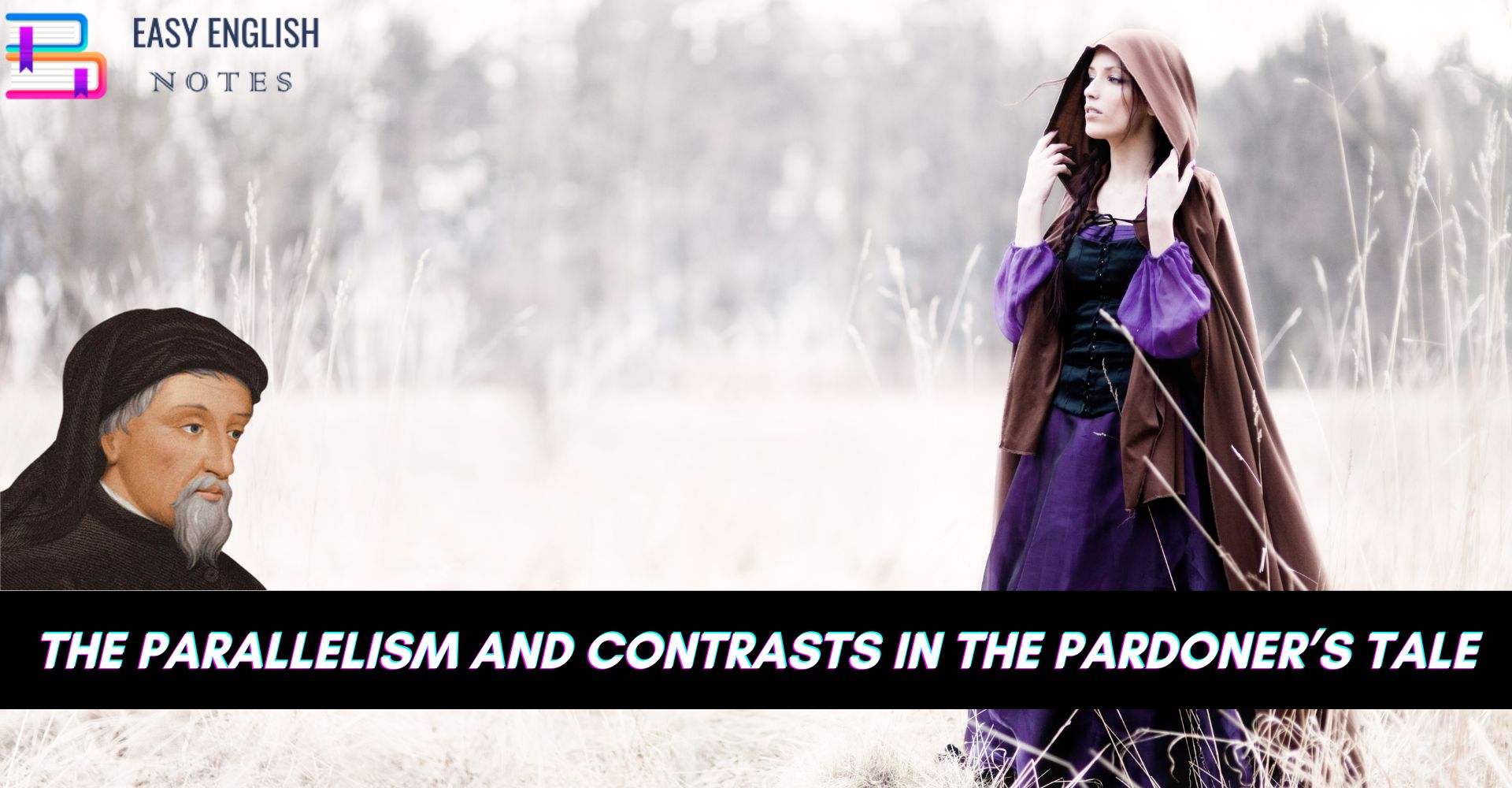There is architectonic quality in The Pardoner’s Tale. There is in it an inevitability which we find in the plays of Shakespeare. Even the Prologue and the Sermon-Interlude are interlinked with the tale proper by avarice and the deadly sins of drinking gambling and swearing. Character is destiny for the three Rioters are the authors of their own woes. The structure, like a drama of Shakespeare, is tight. Really speaking The Pardoner’s Tale reads like a drama. Different parts of the poem: are harmonised together. The poem is a unified whole. There are many things which contribute to the unit. One of them is the unifying irony. The other is parallelism and Contrast.
Parallelisms and contrasts. Like the irony, run throughout the poem and contribute to its unity. Let us now discuss them one by one.
- Parallelism
(1) The Pardoner exposes his weaknesses in the Prologue of the poem. It is paralleled by the self-exposure at the end of the poem.
(2) The Pardoner denounces the deadly sins in the Sermon-Interlude. This is paralleled by the denunciation of these sins at the end of the Tale.
(3) In the Prologue the Pardoner persuades the simple members of the congregation, to touch or buy the marvellous relics. This is paralleled at the end of the poem when he persuades the fellow pilgrims to kiss his marvellous relics.
(4) There is a sadness which prevails in the beginning of the poem when the Physician tells the tale of Virginia whom her father killed to save her from shame. A similar sadness pervades at the end of Tale when the Three Rioters lie dead.
- Contrasts
(1) The persuasion of the simple folk of the congregation by the Pardoner is contrasted with the persuasion of the fellow-pilgrims at the end of the Tale. But while he is successful with the congregation, be fails with the pilgrims.
(2) There is a contrast between what a Pardoner should be and what he actually is. There is also a contrast between what be preaches and what he practices.
(3) Both the tavern-boy and the Old Man tell the Three Rioters about Death but while the tavern-boy informs them about the “traitor Death”, the Old Man tells them about the whereabout of Death.
(4) Both the tavern-boy and the Old Man appear for a short time and disappear immediately after their function is over. But while the tavern-boy speaks of his mother who told him about Death, the Old Man refers to the “Mother Earth”, the mother of everyone.
(5) The Old Man is contrasted with the Rioters in many ways. The Old Man’s age is contrasted with the Rioter’s youth.
(6) The Old Man is meek and humble while the Three Rioters are rude and arrogant. The Old Man greets them courteously and addresses them as “lords” and “sirs” while the Rioters address him as “Death’s spy” and “old churl”.
(7) The Old Man quotes from the Bible while the Rioters blaspheme.
(8) The piety of the Old Man is contrasted with the boasting of the Rioters.
(9) While the Old Man wants to die soon, as he leads a miserable life, the rioters want to live long to enjoy life.
(10) The Rioters ignorance is contrasted with the wisdom of the Old Man. The Old Man regards wealth as fatal and therefore he runs away from florins but the Rioters are so foolish that they regard florins as their God and kill each other for avarice. The Old Man discards wealth while the Rioters sue wealth.
(11) The Old Man is almost dead but spiritually alive. The Rioters are bubbling with life but they are spiritually dead. The Old Man leads a religious life while the Rioters lead a sinful life. They are addicted to swearing, gambling and drinking.
Parallelisms and Contrasts
- Both the Rioters and the Old Man seek Death, but while the former seeks it as enemy, the latter seeks it as friend, while the former want to kill it the latter welcomes it.
- The Rioters are three in number which is also the number of the Holy Trinity but while the former are wicked and sinful, the latter is holy and sacred.
- The plan of murder of the younger Rioter on the part of the elder two Rioter is parallel by the murder of the older Rioters on the part of the younger Rioter. But while the elder two stab the younger. The younger poisons the elder two.
- Thus the tight structure of The Pardoner’s Tale is unified by the pattern of parallelisms and contrasts. The unity of the Tale is skillfully achieved through the unifying irony and the coherent pattern of parallelisms and contrasts.
PLEASE HELP ME TO REACH 1000 SUBSCRIBER ON MY COOKING YT CHANNEL (CLICK HERE)











